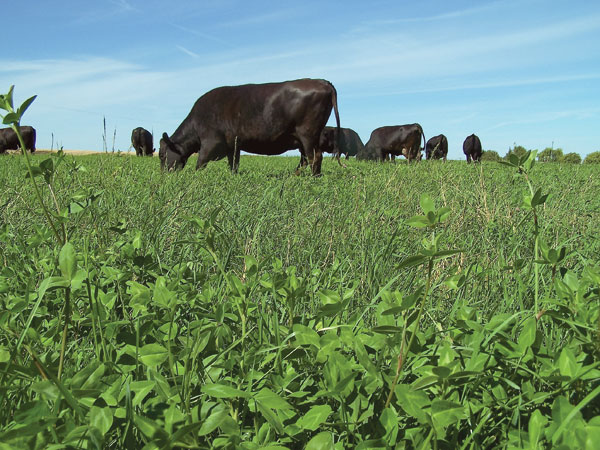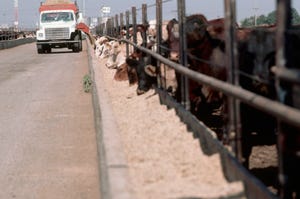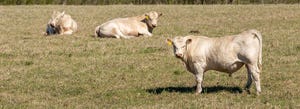High-Sugar Grass Increases Pasture Grazing Gains
High-sugar grass is seen in England as a way to increase pasture gains and further trim livestock’s environmental footprint.
March 27, 2012

 Across the pond in the United Kingdom (UK), there’s a quiet revolution going on that means cow-calf producers – along with their dairy and lamb brethren – are feeding less while making more profits. Live-weight gains are 20% higher than the “old” way, so it’s no wonder the revolution in getting a lot of attention.
Across the pond in the United Kingdom (UK), there’s a quiet revolution going on that means cow-calf producers – along with their dairy and lamb brethren – are feeding less while making more profits. Live-weight gains are 20% higher than the “old” way, so it’s no wonder the revolution in getting a lot of attention.
And now, even Wal-Mart is on board. Wal-Mart’s UK counterpart, Asda supermarkets, has a tight relationship with its meat supply chain and is encouraging its 13,500 farmer-suppliers to get on board, something that could mean an extra $15.4 million/year in the pockets of these producers.
It’s the culmination of three decades of work to develop what is known as high-sugar grass (HSG). Cows and lambs like to eat it so much that dry-matter intakes increase by around 25% in cattle, which leads to significantly higher daily live-weight gains.
Efficient rumen function
These grasses, developed by the Institute of Biological, Environmental and Rural Sciences (IBERS) at the University of Aberystwyth in Wales, began as part of research into rumen function. Along the way, they discovered rumen function improves with water-soluble sugars. Grazing trials and a companion zero-grazing study run by IBERS showed that, when extra energy is provided to beef cattle by feeding Aber HSG varieties with the extra available water-soluble sugars, grass protein is used more efficiently and animal performance is enhanced.
In a separate zero-grazing trial, animals fed an Aber HSG variety recorded high levels of growth performance, with an average live-weight gain of 2.87 lbs./head/day. The bonus was the result of higher forage intakes and greater efficiency of grass utilization, researchers concluded.
Making beef production more efficient is important to producers, but the key for Asda was an anticipated reduction in greenhouse gas (GHG) emissions, thanks to animals eating the HSG. The theory is that when ruminants eat correctly, their bodies use the nutrients instead of producing gases. Studies on lambs showed that the improved rumen function led to reduced GHG emissions (ammonia and nitrous oxide) of up to 20%.
“Does it connect to beef?” asks Nigel Scollan, an IBERS professor and one of the lead researchers on HSG. “Studies [on GHG emissions] have yet to be conducted in other species, but I would expect them to link across because of the production responses in the earlier studies. They’re eating better, there’s higher intake, and it improves rumen function.”
Research will begin this summer on HSG in dairy cows with the results expected next fall. Scollan says the studies will be very important in terms of the move from small ruminants to large ruminants.
Asda encourages the move
But Asda is already encouraging its farmers to trial the grasses in their grazing operations, and is offering a free acre bag of seed for every 10 acres purchased. Asda anticipates that bringing its farmers into the program will help reduce the company’s GHG emissions by 186,000 tons – the equivalent of 78,000 cars off the road.
“This is a first step, the first time anyone has tried to do this, and it will be about how to capture this data as well,” says Chris Brown, Asda’s head of sustainable sourcing. “If farmers are going to be paid for ecosystem services, including carbon, how do we audit that in the field compared to burning oil in a factory? It’s important that agriculture has access to those markets.”
And, that’s how Asda figures farmers in its supply chain will increase profits by $15.4 million/year – basically payment for those ecosystem services through increased production efficiency since they can’t be paid for their animals producing fewer GHG emissions. Animals that gain better on grasses don’t need to be fed as much purchased feed, which can lead to significant savings, Asda reasons.
Slow to move in U.S.
Back on this side of the pond, however, pastures aren’t a high priority for most cow-calf operations. And that’s a waste of resources, says Jerry Hall, general manager and research director of Grassland Oregon in Salem. As the US-based marketer of IBERS’ HSG (SucraSEED™), sold under the BeefBank™ High Sugar Grass Beef Mix brand, he’s found that American producers don’t view their pastures as an input as much as a place to store their animals.
In Europe, where pastureland is scarcer, the average age of pasture is between seven and 10 years because they need to be productive. In the U.S., however, where pasture tends to be more abundant, the average is closer to 30 years. Hall says producers tell him, “I raise cattle, I don’t raise grass,” and they’re looking for grass they can seed once in a lifetime.
“Whether you’re a hay guy or a cattle guy, you’re first and foremost a grass grower. You need to get better at it to maximize your productivity,” he says.
Feed prices continue to soar, and perhaps will even more so now. After all, NutriQuest, a nutritional products and services company in Mason City, IA, expects distillers grain prices to increase nearly $13/ton as ethanol producers begin to extract corn oil to make biodiesel.
Hall says he has about 115,000 acres in the U.S. seeded with HSG, and the productivity results, according to producers and Cornell University researchers, match those of IBERS. It may finally be time to go back and look at the state of those pastures.
Meghan Sapp is a U.S. freelancer based in San Sebastian, Spain.
You May Also Like



